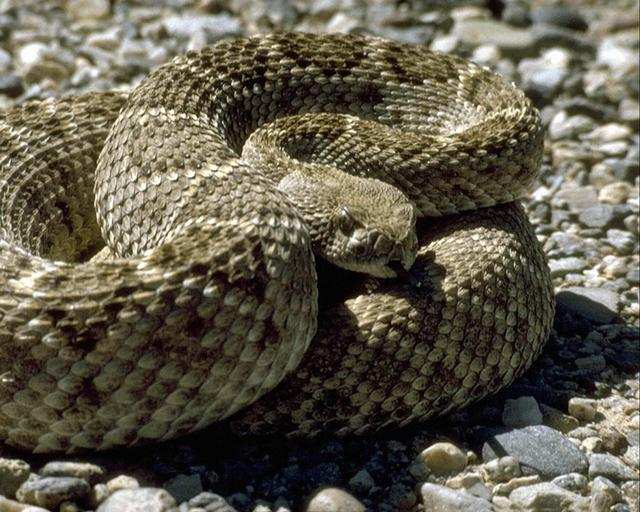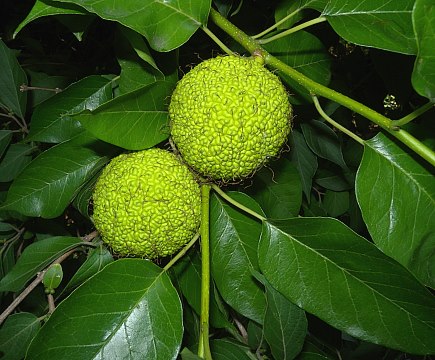STORY LINKS
Devil's Lake
Indian Giants
Mysterious
Lake Michigan
Le Nain Rouge
Paul Bunyan
Sleeping Bear
Dune
Valley
of the Giants
History of
Old Bottles
Michigan
Salt Mines
Kitch-iti-kipi
Eastern Massasauga
Osage Orange
Past Articles
Questions, comments, submissions, & advertising
Contact BPP
|

 Michigan Chronoscope - Stories on the fringe of history
Michigan Chronoscope - Stories on the fringe of history
Chronograph Numeral IV - Fall 2017 - Page Seven
|
Massasauga Rattlesnake
Michigan's Only Poisonous Snake
 Diamondback Rattlesnake
Diamondback Rattlesnake
The rattlesnake is popularly thought of as a slimy, low-down reptile that was an ever-present threat to the cowboys of the Old West. That lesser bad guy was known to crawl into the boots or under the blanket of the hapless cowpoke sleeping under the stars in many a Western movie and TV show. As common as it was portrayed in cowboy movies, a rattlesnake is a rare sight in Michigan. It is so rare nowadays that in all the states outside of Michigan where it was once commonly found it is endangered and here in Michigan it is classified as threatened. Michigan is the final stronghold for the eastern Massasauga rattlesnake (Sistrurus catenatus) with a higher population than any other state within its range. Lucky for us in the Great Lakes State, it is the only venomous serpent to be found.
Although feared and despised for being a rattler, the massasauga is one of the least poisonous snakes in the U.S. and its bite rarely causes death. Regardless, people are conditioned to kill them on sight despite their protected status. In addition, its habitat is disappearing and contributing to its shrinking numbers. Perhaps it is its special swampy habitat, shy nature, and difficulty to see that have allowed the Massasauga to survive as well as it has in Michigan.
Massasaugas are small (about two feet long), thick-bodied snakes with heart-shaped heads and cat-like vertical pupils. The adults are gray or light brown colored with large brown patches on the back with smaller ones on the sides. They have a small rattle on the end of their tail that they shake if startled
They live in and near wet prairies, marshes, and low areas along bodies of water. They often hibernate alone in crayfish burrows and can be found under logs, in tree roots, or small burrows. Like all rattlesnakes, massasaugas give birth to live young. They mate in the late summer and give birth a year later to 5 up to as many as 20 babies.
Massasaugas eat small rodents including mice and voles but they will also eat frogs and other snakes. They hunt by waiting in an ambush. Heat-sensitive pits near their eyes help the snake locate prey. They can also find their prey by sight, vibration, and scent.
Although many people fear the massasauga, it is a shy, docile snake that will only strike a human when it feels threatened or cornered. Even so, living, working, or recreating where they live requires some caution. Snakes like the fox snake, milk snake, and hog nose snake look similar to the massasauga and will even pretend to be rattlesnakes by shaking their tail and striking. However, you should never try to handle such snakes unless you are absolutely certain it isn't a massasauga. Getting bit may not kill you, but it will swell up a hand, arm, or leg to the point it may have to be amputated and the anti-venom is not normally available at local hospitals. Also, the babies are born with the full-strength venom of an adult snake. Being so small they have an underdeveloped rattle and are harder to identify than the adult snakes, making them potentially more dangerous if encountered.
Due to their threatened status, you may not legally harass, trap or kill them. Also, they are so sensitive about their habitat that they could die just from being moved to another area. Because they have a small territory, it would be best to simply avoid the area where they live and be aware of them if you have to travel through their neighborhood. If they are a problem on your property or near your home, you should call a professional from the DNR or forest service to deal with it.
Comment about this article on the
Epress Forum Board
.

|
|
|
The Amazing Osage Orange
 A Remarkable Pioneer Era Tree
A Remarkable Pioneer Era Tree
The Osage Orange (Maclura pomifera), AKA hedge apple, is a remarkable and ages-old multi-purpose tree that few people today know about or have growing on their property. The trees were first named "bois d'arc" or "bow-wood" by early French settlers who noted the wood was used by Native Americans for war clubs and bows.
The earliest English account of the tree was by one William Dunbar during a journey he made in 1804 on the Mississippi River. That same year Meriwether Lewis sent some cuttings to President Jefferson. Lewis, who gave it the name Osage Orange, was told that the people of the Osage Nation ". . . esteem the wood of this tree for the purpose of making their bows". It was highly prized by the Osage tribe because it has dense, strong, flexible, and durable wood.
Before European settlement, the Osage Orange's range was a small area in the Red River drainage of Oklahoma, Texas, and Arkansas. It has since become widely naturalized in the United States and Ontario, Canada. Osage orange has been planted in all 48 states of the continental United States and southeastern Canada.
The tree grows to about 40 to 60 ft tall with a short trunk and rounded canopy. The roots are thick and covered with a bright orange bark. The bark on its trunk is dark, furrowed, and scaly. The wood is bright orange-yellow with pale yellow sapwood. The leaves are thick, firm, shining dark green above and pale green on the underside. In fall the leaves turn a bright yellow. The leaves also contain spines about 1 inch long. The fruit's size and appearance resemble a large, yellow-green orange about 4 to 5 inches in diameter and contains a milky, sticky, gummy juice.
Although the fruit is not poisonous it is mostly inedible due to its taste and hard texture. The seeds of the fruit are eaten by squirrels, but few animals will eat it. This is strange because large fruit normally acts as a means of seed dispersal by being consumed by larger animals. Because of its adaptability and its limited historical range, the natural form of seed dispersal for the Osage orange has been a mystery. One theory is that the fruit was eaten by the giant ground sloth that became extinct after the first human migration into North America. Once its natural range diminished it was likely cultivated by certain Native American tribes for the diversity of its uses.
The name Hedge apple came about because settlers used it as a natural fence to pen their livestock in. Once the barbed wire was in common use, the planting of Osage orange as a property border mostly ended. Hedge apple folklore claims that it acts as a repellent to insects and spiders so the dried fruit had been placed in households for this purpose. When dried its wood has the highest BTU rating of all firewood and was considered the next best thing to coal for heat output. Its wood is very rot-resistant as well. When the railroads discovered the Osage orange, they got it from where ever they could find it for firing the steam engines and for rot-resistant railroad ties. Because of that and how it was no longer used as a natural fence, the Osage orange began to disappear from the American landscape.
Although Osage orange trees are not grown for hedge fences anymore, the hardwood still has its uses. It is frequently used for things like fence posts and furniture and archers consider the wood to be the world's finest for making bows.
Comment about this article on the
Epress Forum Board
.
|
|
Keywords: Michigan, Great Lakes, history, amazing, astonishing, baffling, bizarre, cryptic, curious, different, extraordinary, forgotten, hidden, incredible, inexplicable, legends, lore, lost, myths, obscure, odd, peculiar, rare, stories, strange, surprising, tales, unexplained, unfamiliar, unique, unknown, unusual, weird
|
|



